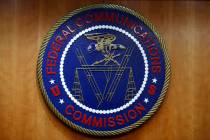Sealed cases not tracked
Clark County's District Court authorities now admit they don't know how many lawsuits have been sealed from public view, why they were sealed, how many were sealed inappropriately, or who sealed many of them.
Judges making their own rules, clerks sealing court records without legal authority, and an outdated computer system were causes courthouse administrators last week blamed for interference with public access to court records that should not have been sealed.
Though ongoing for years, the scope of the problems was brought to light only after a Review-Journal series earlier this year and the court's subsequent examination of its own practices.
Chief Judge Kathy Hardcastle said the court is developing new policies for handling sealed cases and individual court records, in part because the Nevada Supreme Court is considering statewide regulations on the same issues, and calling on local courts to provide better public access to court information.
"Some of the business practices were put in place 50 years ago when everything was on paper. We are looking at our practices, asking if they make sense and asking that, if they don't make sense, why are we doing it this way," Hardcastle said. "The more we delve into it, the more we realize there is more work there than what was on the surface."
Lucy Dalglish, executive director of the Arlington, Va., based Reporters Committee for Freedom of the Press, said courts in other states and the federal court system are experiencing similar problems with computer databases, and that it's "ludicrous" public access isn't given greater consideration before new computer systems are installed.
"Obviously, this is a problem. We have a presumption in this country, particularly with the criminal courts but also with civil matters, that anything filed with the courts is public. This goes way back to English Common Law. This isn't anything new, and it should have been in the forefront of the brain of anyone who designed a computer system to manage court records," Dalglish said. "This is important and the public has a need and right to know what the justice system is up to."
Entire lawsuits, and individual records within lawsuits, have been sealed from public view inappropriately either because improperly trained clerks entered data into the courthouse computer using inconsistent methods, or because the 15-year-old computer system wasn't programmed to distinguish sealed lawsuits correctly in a database that holds thousands of cases, court administrators said.
Unknown to Hardcastle and other court administrators until recently, clerks were taking it upon themselves to inappropriately seal certain court records without an order from a judge, because they had been instructed to do so for years.
For instance, some courthouse clerks sealed letters written to judges by a litigant, or on behalf of a litigant, in part because judges are forbidden from reading those letters if the case is pending, Hardcastle said. Sometimes the letters would be placed in the case file, and other times they would be sealed without the judge's knowledge or consent, she said.
"They are not sealing some cases that should be sealed, and, in some cases, they are sealing the whole thing (case) when the whole case shouldn't be sealed. ... It's been hard to identify the practices and where the inconsistencies are," Hardcastle said. "In some cases, clerks made the decision to automatically seal case records, even though there was no court order to seal the records. We are identifying these practices so that we can have consistent practices across the board."
The District Court established an internal committee earlier this summer to look at a variety of problems affecting public access to court records, including how sealed cases and court records are handled; how to clean up the records before a new, $8.1 million computer database is launched next year; and how to protect personal information contained in court records while making them public, Hardcastle said.
The chief judge formed the committee partially in response to a request from the state Supreme Court's Commission on Preservation, Access and Sealing of Court Records. The commission requested that each district court across the state provide information on sealed cases by July 15, but Clark County still hasn't complied a month after the informal deadline.
The Supreme Court established the commission, which is comprised of jurists, attorneys, and members of the media, to look at issues surrounding sealed lawsuits and the authority that some judges have claimed to seal civil cases at their discretion.
The commission is expected later this month to consider regulations that should define and limit a judge's authority to seal civil cases. State law spells out a judge's authority to seal criminal and Family Court records, but it doesn't address civil cases.
Hardcastle said she expects to file the overdue report next week, but cautioned that it will take time to overhaul long-standing practices.
The commission's request has been helpful, Hardcastle said, because it forced the court to examine its deficiencies in the area of sealed cases and correct them. New regulations on judges are welcome as well because consistency is needed, Hardcastle said.
Clark County judges for years have tailored their own practices on sealing lawsuits.
"We don't have a consistent standard, so they are exercising their discretion, and some (judges) are fairly liberal and others are strict in allowing court records to be sealed," Hardcastle said.
Supreme Court Justice Jim Hardesty, who co-chairs the Supreme Court commission, said last week he is withholding judgment on Clark County's predicament until after he receives Hardcastle's report.
Hardesty said he is pleased that Hardcastle has taken seriously the commission's request and is aggressively trying to correct problems in the handling of sealed cases.
"They took considerable time looking at the issues in the letter," Hardesty said.
Chuck Short, Clark County District Court administrator, said the court must not only get its judges and clerks to devise and follow consistent procedures about sealing records, but also must correct many of the records themselves before the new computer database is installed next year.
The courthouse computer wasn't programmed to distinguish sealed lawsuits from other civil cases, which may have only one or two sealed records among the dozens contained in the entire case file.
It's common for judges to seal particular court records that if made public would divulge trade secrets, confidential information about minors, personal financial information, personal identification data such as Social Security numbers and other information which litigants might legitimately need to keep private.
The computer error, although a problem since the computer system was installed in 1992, wasn't noticed until earlier this year after the Review-Journal requested public information on sealed lawsuits, Short said.
The same problem hasn't affected sealed criminal court records, because they are coded into the computer differently, Short said.
"With respect to the civil caseload, it's hard to distinguish whether a case has a record sealed or whether the entire case is sealed," Short said. "You would have to go case by case to determine whether a case has a record or two sealed or whether the entire case is sealed."
The database contains tens of thousands of cases.
Short said it's vital that court staff separate the sealed cases from the cases with a record or two sealed before any case information is fed into the new computer database next year.
Staff could identify all those cases that are sealed or have a sealed record and separate them so the same confusion isn't duplicated, he said.
However, the situation could prove more difficult than that.
The Review-Journal located several sealed lawsuits in the database that were missing from a list of sealed cases provided to the newspaper by court administrators earlier this year. The newspaper received a list of about 390 sealed lawsuits filed between 1990 and 2006.
Since receiving the list, and while doing research on sealed cases and other topics, the newspaper came across a dozen lawsuits that had been sealed since 1990 and that were not included on the District Court's computer-generated list of sealed cases. If the computer database couldn't identify all the sealed cases for the Review-Journal, the question arises whether it can provide a comprehensive list for court administrators.
For instance, none of the five sealed lawsuits involving controversial real-estate developer Jim Rhodes were included on the list of sealed civil cases provided to the newspaper. Nearly one lawsuit per year involving Rhodes was sealed by a judge between 1998 and 2003, a period during which he was sued by home buyers, business partners and others.
Rhodes, the developer of the Rhodes Ranch development in southwest Las Vegas whose bid to build a massive housing project next to Red Rock Canyon was shelved in the face of public outrage, was mentioned as a generous campaign contributor during the recent bribery trials involving former county commissioners who are now in prison or on their way there.
Conflicted Justice




























